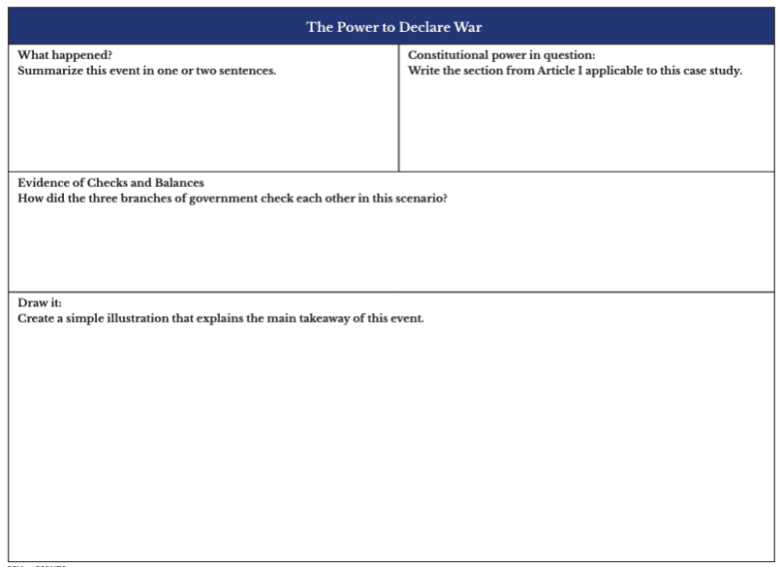Graphic Organizer Checks and Balances Case Studies
How have the interactions among the three branches of government changed over time?
Check and Balances Graphic Organizer
Objectives:
- I can apply the concept of checks and balances to case studies across U.S. history.
- I can analyze continuity and change over time in the interactions among the three branches of government.
Directions: Complete the graphic organizer as you read the case studies. Then, respond to the Assess and Reflect questions that follow.

Caption: The House of Representatives’ Judiciary Committee opening its formal impeachment hearings against President Richard Nixon on May 9, 1974
Impeachment Process: Watergate |
|
| What happened? Summarize this event in one or two sentences. |
Constitutional power in question:
Write the section from Article I applicable to this case study.
|
| Evidence of Checks and Balances How did the three branches of government check each other in this scenario? |
|
| Draw it:
Create a simple illustration that explains how Congress checked presidential power.
|
|
Analysis Questions
- What role did the legislative and judicial branches play in holding members of the Nixon Administration accountable for their actions?
- How did Congress and the Supreme Court work together to prevent unchecked presidential power in the Watergate case study?
- What role does Congress have in the process of impeaching a president?
The Power to Declare War |
|
| What happened? Summarize this topic in one or two sentences. |
Constitutional power in question:
Write the entire phrase from Article I applicable to this case study.
|
| Evidence of Checks and Balances How did the executive and legislative branches check each other in this scenario? |
|
| Draw it:
Create a simple illustration that explains the main takeaway of this event.
|
|
Analysis Questions
- Why did the Framers of the Constitution divide the war power between the executive and legislative branches?
- How does the division of war powers contribute to the principles of separation of powers and checks and balances in the U.S. government?
- Why is it constitutionally troubling for the U.S. to go to war without authorization from Congress?
The Commerce Clause and Judicial Review |
|
| What happened? Summarize this topic in one or two sentences. |
Constitutional power in question:
Write the entire phrase from Article I applicable to this case study.
|
| Evidence of Checks and Balances How did the three branches of government check each other in this scenario? |
|
| Draw it:
Create a simple illustration that explains the main takeaway of this event.
|
|
Analysis Questions
- What is the principle of judicial review, and why is it important in maintaining checks and balances in the U.S. government?
- What was the Court’s constitutional stance on Congress’s attempts to regulate the economy during the early twentieth century and the New Deal era?
- How has the exercise of checks and balances over time shaped the understanding and application of the Commerce Clause?
- What broader implications does the discussion of the Commerce Clause have on the balance of power within the national government?
Assess and Reflect:
- How have the legislative and the executive branches checked each other over time, based on these case studies? The legislative and the judicial branches?
- The Founders envisioned the legislature to be the “First Branch” or most powerful branch in the national government. Do these case studies support this concept? Explain.
- Based on these case studies, is there evidence of balanced power among the three branches of government today? Explain.
